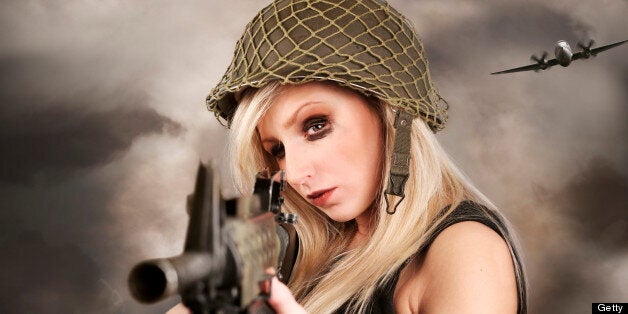
In Germany right now, women are making headlines. Number one is Angela Merkel. Second comes Beate Zschäpe (pronounced Chayper). She's on trial for murder (10 counts), attempted murder, arson, bank robbery and membership of a terrorist organization. (A charge of possessing child pornography has been dropped.) The trial will last for years, but the public has already decided: Zschäpe is a Nazi, a terrorist killer - and a super-celeb.
But why is everyone so interested in Zschäpe: her clothing, her hair style, how she gossips with her lawyers? Movie stars kill for such coverage. Why does the public find her so much more interesting (fascinating even) than it finds her male co-conspirators? Women and terror. Try putting a name to all the terrorists (male or female) you can remember. Chances are half of them are women. Odd.
So let's try some names. In 1974, Minor Planet 2283 was discovered orbiting between Mars and Jupiter. It was named after Tamara Bunke. You haven't heard of Tamara? She's better known as Tania, the only woman to fight in Bolivia alongside Che Guevara's doomed guerrillas. Tania was certainly a terrorist. And they named a planet after her? Weird.
Tania was the alias of a terrorist you probably remember as Patty Hearst, granddaughter of Randolph the newspaper giant. Patty famously gave her occupation as "urban guerrilla" when she was jailed in 1975. The CCTV shot of Patricia Soltysik leaving the Hibernia Bank with the loot while Hearst stands guard is iconic.
So how far do women terrorists go back? Depends on how you define terror. Caligula, Robespierre, Stalin (no female examples) practiced one kind of terrorism - terrorism from above. Terrorism from below is different: it is the violent pursuit of a political programme by an organized group. Where did it start? Who invented it?
Maybe the suffragists. American? British? In 1913, Inez Milholland on a white horse led a non-violent suffrage parade of 8000 women through Washington. Sadly the spectators turned violent, though not the protesters. Milholland's dying words embody her programme: "Mr President: how long must women wait for liberty?" Wait, not fight. No terrorism there.
British women marched to a different drummer: writing on walls, breaking windows, slapping policemen. To escalate pressure, Lilian Lenton (and others) took up arson. The Theatre Royal in Dublin, the Orchid House in Kew, the refreshment kiosk in Regent's Park were torched. Putting greens were destroyed with acid. According to Elizabeth Crawford, Lenton planned "to create such a condition in the country that it would prove impossible to govern without the consent of the governed." That is terrorism pure. And the death-wish is there: hunger strikes and forcible feeding. Once, in Holloway, the feeding tube penetrated Lenton's lungs and she contracted septic pneumonia. Frighteningly heroic as they were, the suffrage terrorists were small-scale - and not the first.
Terror as we understand it today needs three things: a big bang (to focus attention), fast transport (to get away) and fast communications (to organize). That all came together in the 1870's with dynamite, the railways and the telegraph. The first group to exploit this combination was the People's Will led by Sofya Luovna Perovskaya, the most wanted woman in Imperial Russian. Perovskaya's father had been Governor of St Petersburg. She'd trained as a midwife. She was ugly and half deaf (an injury inflicted by her father). For her, the "big bang" was the assassination of Tsar Alexander II. She plotted and struggled till on an icy embankment in Petersburg in 1881, a bomb ripped off the Tsar's legs and the stump of his body was carted back to the Winter Place to die.
Perovskaya was terror personified: ruthless, selfless and murderous. She epitomizes the old saying: "Men fight to win: women fight to kill." Or as Kipling put it: "The female of the species is more deadly than the male." Not long after the Tsar's assassination she was publically hanged.
Perovskaya invented terrorism from below. So is a planet after her? There is a Planet 5319 Perovskaya, but it's named after Margarita, the astronomer. Even so Sofya's name survives while the men around her are long forgotten. There's a Soviet film about her - with music by another famous protester, Dmitri Shostakovich.
Though women are under-represented in the board rooms of power, under-representation is definitely not a problem in the conspiratorial apartments of terror.
Jim Pinnells' latest novel, Saturn's Daughters, is the story of Sofya Perovskaya and the late 19th Century Russian terrorist group the People's Will. It is out now and available from Amazon.